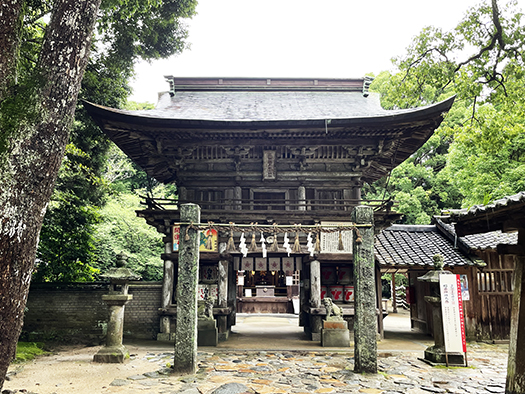
やっぱり九州は遠い。いろいろな知識を得ると言うこと自体は現代では容易に可能だけれど、実際に来て見てはじめて「気付く」ことには敵わない。
今回の九州旅は、ほぼわたしは「ボーッと」しているわけですが、そういうなかでもふと道端の「地名」を見て、「あっ」と膝を打つ瞬間が巡ってくる。そうなのです、糸島に行こうということが前日夜のカミさんとの会議で決まって、実際にクルマを走らせて糸島の海岸線を走り始めて、そこで「伊都」という地名表示を見てしまった。「え、糸島って伊都国?」という怖ろしく鈍感極まりない気付き(笑)。これだから旅は面白い。
〜糸島は、玄界灘を挟んで朝鮮半島、中国大陸と接するという地理的条件から大陸との接点として栄え日本文化発祥の地である。今から2000年以上も前から、稲作文化を始めとする新しい文化が続々と到来し、この地で花を咲かせたことが証明されている。邪馬台国論争では欠くことの出来ない『魏志倭人伝』にある伊都国は、まさにこの地である。伊都国は弥生時代中期を過ぎたころに誕生した。その『魏志倭人伝』をはじめ『古事記』『日本書紀』『万葉集』などの古典において、その存在を求めることが出来る。紀元前後約200年間伊都国は、前漢、後漢王朝の傘下にあって倭国の中枢として政治、外交の拠点となり、弥生時代の我が国の都であったと言っても過言ではない。あの有名な『漢委奴国王』の金印に遅れること50年、『107年倭国王・帥升(すいしょう)等が後漢へ生口160人を献じ、謁見を請うてきた。』と後漢書東夷伝に記されてあるが、この『倭国王帥升』は奴国の隣・伊都国の王で、倭国連合の王ではないだろうか?〜<「魏志の倭人伝の伊都国」 http://www.iokikai.or.jp/kodai.itokoku.htmlより引用>
きのうの神功皇后ゆかりの宮地嶽神社といい、まさに古代史の伝承がいまにも生き生きと根付いていることを実感させられる。これまで奈良県南部地域〜熊野一帯に完全に古代史の興味が集中していたことを深く気付かされ、この北部九州は汲めども尽きせぬ民族のルーツに深く関与していることに気付き、思い切りホッペを張られた(笑)。まことに痛快。
同時にムクムクと古代史探訪の意欲が湧いてきてたまりません。写真は糸島地域の「櫻井神社」社殿。今回は粛々と体験・体感中心に受容させていただき、帰ってからは探究に没頭したいと思います。伊都国の先人の方々、よろしくお願いします。
English version⬇
Itoshima, Fukuoka City, and “Itokoku” in Wei Wei’s biography
I was slapped hard by a man who asked me, “Are you so absent-minded that you have forgotten the book of Wei-Shi-Wa-jin-den? I was painfully knocked down, but I am still in bed. I would like to learn from him. I would like to learn from him.
Kyushu is a long way away. It is easy to gain knowledge of various things nowadays, but nothing can compare to actually visiting a place and noticing it for the first time.
I was mostly “absentminded” during this trip to Kyushu, but even in such a state of mind, I would see a “place name” on the side of the road and have an “ah-ha” moment. The night before, my wife and I had decided to go to Itoshima, and as we started driving along the coastline of Itoshima, I saw a sign that said “Ito” (伊都). Itoshima is Ito-kuni? I was so scared and insensitive to the fact that I was driving along the coastline of Itoshima. This is why traveling is so interesting.
〜Itoshima is the birthplace of Japanese culture, and has flourished as a contact point with the continent because of its geographical location, bordering the Korean Peninsula and the Chinese mainland across the Genkai Sea. It has been proven that new cultures, including rice cultivation, arrived here more than 2,000 years ago and blossomed here one after another. Itsukoku, mentioned in “Wei-Shi-Wa-jin-Den,” which is indispensable in the debate on Yamataikoku, is the very place. Itsukoku came into existence after the middle of the Yayoi period. Its existence can be found in such classics as “Kojiki,” “Nihon shoki,” and “Manyoshu,” as well as in “Wei shi wajinden. It is no exaggeration to say that Itsukoku was the capital of Japan in the Yayoi period, and was the center of politics and diplomacy of Japan for about 200 years before and after AD under the Han Dynasty. In the year 107, the king of Japan, Suisho, and others presented 160 people to the Later Han Dynasty and requested an audience with them. The “King of Japan, Suisho” was the king of Itsukoku, a neighboring province of Nukoku, and was probably the king of the Japanese Confederation. ~ <"Itsukoku in the Biography of Wei Wei" http://www.iokikai.or.jp/kodai.itokoku.html>
The Miyajitake Shrine, associated with Empress Jingu, as seen yesterday, reminds us that the traditions of ancient history are still vividly alive and well in the present. I was deeply reminded that my interest in ancient history had been completely focused on the southern area of Nara Prefecture and the Kumano area, and I was made to realize that this northern Kyushu region is deeply involved in the unending roots of our people, which made me feel very proud (laugh). It was truly a painful experience.
At the same time, I am very eager to explore the ancient history of Kyushu. The photo is of the shrine pavilion of Sakurai Shrine in the Itoshima area. This time, I will be solemnly accepting the experience and sensation, and after returning home, I would like to immerse myself in the exploration of the history. I would like to express my gratitude to the predecessors of Itokuni.
Posted on 6月 29th, 2024 by 三木 奎吾
Filed under: 歴史探訪







コメントを投稿
「※誹謗中傷や、悪意のある書き込み、営利目的などのコメントを防ぐために、投稿された全てのコメントは一時的に保留されますのでご了承ください。」
You must be logged in to post a comment.